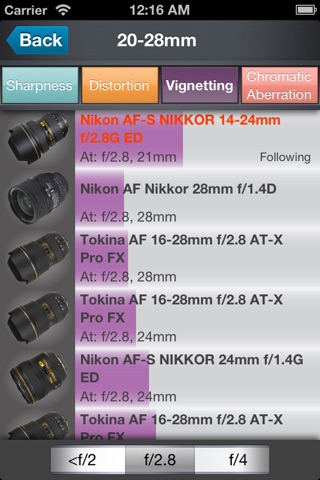
The Nikon F-mount is a type of interchangeable lens mount developed by Nikon for its 35 mm Single-lens reflex cameras.
This App contains more than 130 lens information of Nikon mount.Lenses include Nikon,Sigma,Tamron,Tokina,Zeiss and Voigtlander.
This App also has many calculators for photographic formulas, include DoF Calculator, FoV Calculator, FoA Calculator, CoC Calculator, Magnification Calculator.
Functions as follows:
1 Measurements:
Contains Sharpness,Distortion,Vignetting,Chromatic Aberration and Specification data. Some lens at the same time with FX-DSLR and DX-DSLR data.
2 Ratings:
Lens in accordance with the Sharpness, Distortion, Vignetting, Chromatic Aberration sort, and follow the lens is listed first.You can focus the lens of interest, the level of these lenses can be easily seen in the sort.
3 Comparisons:
You can contrast at all focal lengths and aperture any lens, and results in accordance with the focal length divided into a number of forms.
4 Depth of Field Calculator:
This view lets you calculate the depth of the field of acceptable sharpness in a displayed image. This depends on the subject distance, focal length, aperture, and the circle of confusion (CoC). The program calculates the CoC value based on the film size, but you can put your own value in, if you like.
5 Hyperfocal Distance Calculator:
In Depth of Field tab display.
5 Field of View Calculator:
The "field of view" calculator lets you solve two photographic problems. The primary one is, given a film size, lens length and distance to the subject, how much of the subject fits in the frame? By fiddling with the calculator a bit, you can also solve a slightly different problem: given a film size and lens length, how far away does one have to be to take a picture of a subject of a certain size?
6 Angles of View Calculator;
Imagine a rectangular pyramid projected from your cameras lens, with the point just behind the imaging area. This pyramid expands from this point to enclose the imaging area and then out through the lens to encompass the area that the camera can "see." The imaging areas aspect ratio forms the shape of the pyramid, and the lenss focal length dictates how that pyramid spreads from the camera outwards. A shorter focal length results in a flatter pyramid, and the wider the imaging areas aspect ratio, the less symmetrical the pyramids base is.
7 Diameter of circle of confusion Calculator:
This view lets you calculate the diameter of circle of confusion.



